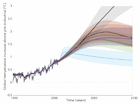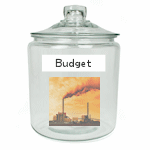The Clock is Ticking...
Climate Scientists - Smart People

Now those climate scientists, they're a pretty smart bunch. They spend a whole lot of time thinking about ocean temperatures, atmospheric convection, carbon sinks (say what?), latency of greenhouse gases and what not. It gets really technical (and cool too!) pretty quickly.
They're the group that thinks about whether climate change is really human made or not (it is), the impact of volcanic eruptions (turns out they cool things down - at least for a while), the impact of sea temperature changes on hurricanes, droughts, rainfall, sea level change, and all kinds of stuff that's pretty technical.
Computer Models - Tools to Peer Into the Future

But the really cool thing is they do is build smart computer models that predict the impact of climate change in the future. They base them in part on how much CO2 we're emitting now and could be in the future, which of course depends on us, but assume it's a lot for now.

The other smart thing they do, knowing full well this is complicated, is estimate how confident they are in their projections. So it's not only how hot the planet could be, but how sure they are it could be that hot...make sense?
Then they sit in big meetings and argue for hours about who is right, which is a good thing because they are challenging each others assumptions. After all these debates and discussions, and the resulting updates to the models, they issue a consensus opinion. The lead global organization doing all of this is the IPCC (the Intergovernmental Panel on Climate Change). They're the group that got the Nobel prize a few years back - not too shabby! -but there are many others.
The Climate Bathtub - It's Filling Up Fast
Now because those models are so complicated, it's worth having a simpler picture of what's going on. We like the bathtub analogy...it's pretty straight forward...so stick with us.

Now the reason we think the bathtub model is helpful is because it's tough to keep track of where all that CO2 is going. We emit billions of tons every year and it seems to just disappear. How can that be?
Well the short answer is it's going to three places: a good chunk is hanging around in the sky (but you knew that), a large part is dissolving in the oceans (turns out this isn't a good thing), and the last major portion is getting captured by plants and soils.
But back to the bathtub. You can think of our combined emissions (from our power plants, chimneys and tailpipes), like a huge faucet filling it up. But unlike your tub at home, the drain is open, so it's draining out at the same time were pouring it in. Not that sounds a little odd, but it's a good way of thinking about our current emissions.
In the case of CO2, our emissions pour 9.2 billion tons (per year!) into the tub. Of this, 5.2 billion tons 'drains', or rather, is captured by plants or dissolved in the oceans, and a whopping 4 billion tons (the portion that doesn't get drained), remains in the atmosphere. It's that portion that acts like a blanket that kicks in to heat things up. The part that goes into the oceans (~2.3 billion tons per year) is starting to change their basic chemistry, but more on this later.
And because we're filling the tub MUCH faster than it's getting drained, ...you guessed it, it's starting to overflow.

One last point: it turns out that the fill level represents the concentration of CO2 in the atmosphere, which is currently a whopping 400 parts per million (ppm). This may not sound like a lot, but remember that before we started using fossil fuels we were at ~270 ppm. So we're currently running ~ 50% higher than pre-industrial levels.
Now that might not be keeping you up at night, but all that excess CO2 is working somewhere on this planet, 24 hours a day, 365 days a year, doing its heating thing.
The Lag Effect: Oceans Heat Slowly and CO2 Hangs Around for Long Long Time
Now it turns out all that gas we put up in the atmosphere hangs around for a long long time. It's kind of like that blanket we were talking about earlier; not only are we making it thicker (by putting excess CO2 in the sky), but once it's in place, it's almost impossible to take off. Yes, eventually (we're talking thousands of years), it will all get absorbed into the ocean, or captured by growing plants, but all the time it's hanging around it will have its heating effect.
CO2 is literally the gift that keeps on giving....wow!

Not only that, in an even more interesting twist, it turns out that a lot of the heat that goes into the ocean gets mixed into the top 100 meters. So although the land heats quickly, the surfaces of the ocean, which have a huge ability to absorb energy, heat slowly.
So we have a double whammy effect when we emit CO2. It has both short term (we're talking decades), and long term (we're talking centuries), impacts, and along the way it has plenty of time to heat up the oceans, which are like the supertankers of all cast iron heaters; they're slow to heat up ...and very slow to cool down.
The long term effect is call the "lag" effect, and all it means is the more we emit now, the more we're stacking the deck against a stable climate in the future.
Our Carbon Budget

Well given that C02 hangs around for such a long time, you can think of our emissions as having a budget. Once the tub is full, there really is no turning back. Because of the lag effect, the greenhouse gases we emit today will heat the planet for a long long time. As a result, the atmosphere will warm and we'll be locked into a permanently changed climate that will be tougher for us all.
In fact, we can think about it like this: for every additional Ton of greenhouse gas we put in the sky there is a permanent increase in global temperatures . And because scientists agree we must keep the heating of the Earth below 2ºC (3.6ºF), we can calculate how much CO2 we can emit before we cross the red line.
Now who would have thought that in advance? We've been happily going about our business using fossil fuels and now there's a cap!? Yup. It takes a minute to sink in...but there is a physical cap from an emissions perspective. If we cross it, all bets are off.
Current estimates put this cap at ~3700Pg CO2 to give us even odds of not crossing the 2ºC line. Now this sounds like a lot, but it's not. Given we've emitted half of this amount to date (we've been doing lots of work and play the last 100 years), at our current high emissions levels we would hit this in 50 years! After that we could use no more. It's like fossil-fuel lights out for 9+ billion people on the planet (or more). That's simply not going to happen.
To assure we don't cross the red line, we need to start reducing significantly...today. If we start now we can reduce emissions at a manageable level (to be technical, ~3.5% to 4% per year). If we delay, say 5 or 10 years, it gets more and more difficult. If we don't start for another decade, it's unlikely we'll make it at all.
The Window of Opportunity is Closing

So this brings us time...which as we know, there is never enough of.
It turns out that the window of opportunity to mitigate Climate Change is closing. Due to the long-lasting effect of emissions, if we delay we will have to make steeper reductions in the future AND reduce emissions to lower levels. If we delay the start of reductions we will use more of our emissions budget earlier, which means we will have to emit less CO2 in the future - requiring a steeper reduction in emissions. Make sense?
Another reason we need to get cracking is we're currently tracking on the high side of historical emissions forecasts. Despite pledges from the international community, including the US, our global emissions are on a path to a substantially warmer world.

The Bottom Line

The bottom line is we need to get moving. Because we have a budget on CO2 emissions, every year we delay conservation efforts will make it tougher to achieve the reductions we need.
And although it's still too early to say "too-little-too-late" for achievement of stabilization at either 1.5ºC or 2.0ºC, we're tracking on the high side of forecasts.
There is a window of opportunity to prevent climate change from becoming too severe. If we act now, we can, collectively, secure our future and the ecosystems and species on which we depend.
The not-so-good-news is if we don't get moving soon, the climate changes we are causing would be practically irreversible.
References
R. Kunzig (2009). "The Big Idea", National Geographic. graphic: N. Holmes, J. Sterman, D. Archer
Hansen J, K. P., Sato M, Ackerman F, Hearty P J, et al. (2012). "Scientific Case for Avoiding Dangerous Climate Change to Protect Young People and Nature." Cornell University Library, Ithaca, NY arXiv:1110.1365v3.
Peters, G. P., R. M. Andrew, T. Boden, J. G. Canadell, P. Ciais, C. Le Quere, G. Marland, M. R. Raupach and C. Wilson (2013). "The challenge to keep global warming below 2 [deg]C." Nature Clim. Change 3(1): 4-6
US National Climate Assessment Development Advisory Committee (NCADAC) (2013). Climate Assessment Report.




